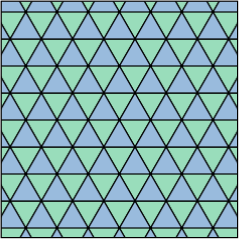This article was published in Scientific American’s former blog network and reflects the views of the author, not necessarily those of Scientific American
It’s no secret that I have a thing for hyperbolic geometry. I could, and sometimes do, spend hours just thinking about pretty shapes in the hyperbolic plane. So when I found a tool that lets you make your own pictures into pretty hyperbolic shapes, I spent quite a while with it. The tool was created by Malin Christersson, who has a nice selection of non-Euclidean geometry pages on her website as well. If you'd like to learn more about the hyperbolic plane before reading the rest of this post, check them out.
The Euclidean plane (or your floor or bathroom walls) can be tiled with equilateral triangles, squares, or hexagons. Those shapes fit together perfectly to cover the plane without overlapping, and those are the only regular shapes that can do it. (Many irregular shapes can too, including a brand new type of pentagon that's been making a splash with math enthusiasts.)

A tiling of the Euclidean plane by equilateral triangles. Image: R. A. Nonemacher, via Wikimedia Commons.
On supporting science journalism
If you're enjoying this article, consider supporting our award-winning journalism by subscribing. By purchasing a subscription you are helping to ensure the future of impactful stories about the discoveries and ideas shaping our world today.
When we tile the hyperbolic plane, we have more freedom than we do in the limited Euclidean world. We can tile it with equilateral triangles, quadrilaterals, pentagons, hexagons, and so on. Not only that, we can do it infinitely many ways with each of those shapes. Angles are much more restricted in Euclidean space than in hyperbolic space. All Euclidean triangles have a total angle sum of 180 degrees, while in hyperbolic space, triangles can have any angle sum under 180 degrees. In Euclidean space, equilateral triangles have 60 degree angles, so the only way to fit them together in the plane is to put six of them around one point. In hyperbolic space, on the other hand, some equilateral triangles fit seven around a point, some eight, some 50, and some even infinitely many around each vertex.
Christersson doesn’t quite have an infinite number of tilings available, but you will find plenty to play with. Hyperbolic tilings are often labeled by what type of shape is used and how many of them fit around each vertex, so a 4,6 tiling means there are six quadrilaterals around each vertex, and a 6,4 tiling means there are four hexagons around each vertex. On the tiling tool, the number p is for the type of polygon, and the number q is for how many of them should go around a vertex.
The tilings are all based on the Poincaré disk model of the hyperbolic plane, and Christersson has some information about the hyperbolic plane and some of the options she's given you. As you're playing around, see if you can identify what type of tiling a picture uses based only on the final image. Can you tell whether you tiled it with triangles or hexagons? How many of the shapes were around each vertex? Can you figure out why some combinations of p and q are not allowed?
If you’re trying to decide what pictures to use, M. C. Escher’s Circle Limit paintings, which are similar in spirit but were made by hand instead of generated on a computer, featured angels, devils, lizards and fish, but empirical evidence suggests mathematicians make attractive subjects as well.
Update: check out my hyperbolic tiling album on Google+ and share your photos with me there, here, or on Twitter.